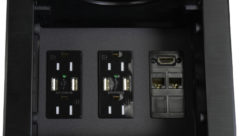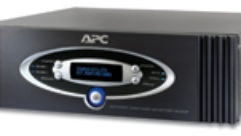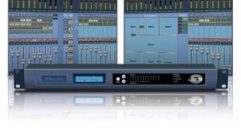
Furman AR-15 Series II
Feb 1, 2006 12:00 PM,
By John McJunkin
Regulating voltage is the first step toward great audio.
I have been a great fan of voltage regulation and power conditioning for quite some time now, and I was excited to get my hands on Furman’s AR-15 Series II unit. The reality is voltage regulation is not just a luxury, but truly a necessity. Frankly, I have suffered equipment losses to spikes in years past, and I have sworn that I will never lose another piece of gear to a transient. I very adamantly recommend that contractors and integrators use some kind of device to regulate and clean up their AC. In addition to gear-saving transient clampdown, it makes sense to keep power regulated in critical applications since one can nary afford having a brownout degrade or even shut down audio and/or video. Furman is well known for its power-regulating devices, and the AR-15 Series II is the latest addition to the line. Let’s take a look.
WHY REGULATE?
There are three primary purposes for using a voltage regulator/power conditioner. The first is to protect your equipment from surges, spikes, transients, and other nasty bugaboos that can literally destroy your equipment. This one is the no-brainer. Nobody wants to fry his or her equipment.
The second is to guarantee a certain amount of current and a stable voltage. To a large extent, this one is also a no-brainer. A competent contractor or systems integrator certainly wishes to ensure that the “show will go on,” as it were, under any and all circumstances.
Finally, the third purpose for voltage regulation and power conditioning is to increase the quality of the audio and video being presented. This, while lower on the priority totem pole, is still an important aspect. I would submit that we go out of our way to provide high-quality speakers, video monitors, amplifiers, and microphones in an attempt to maximize quality. Power conditioning can have a profoundly positive impact upon the quality, and should be very strongly considered. It may not be the first priority on the list of means to provide quality signals, but it should be somewhere on that list. And if providing high quality is the lowest of the three priorities here, it should be pretty obvious that you should strongly consider the use of such units if you have not already.
THE BIG HEAVY BOX
I pulled the regulator out of the box to discover that this 1U rack-mount box is heavy — I say that sarcastically, but it is substantial! There’s a big, fat toroidal transformer inside contributing the lion’s share of the unit’s weight. That’s how it accomplishes its magic — a multi-tap toroidal transformer. On the front panel, from left to right, there is a multi-segment LED voltmeter displaying the input AC line voltage in meaningful increments from 75V to 150V. At 101V and 137V, the LEDs are yellow, indicating that the voltage is approaching unusable levels. The ranges from 75V to 98V and from 140V to 150V, respectively, are represented by red LEDs, indicating input voltage either too low or too high for proper operation. The center six LEDs, ranging from 105V to 131V are green, indicating appropriate, usable input voltage. If the input voltage is too low or too high, the regulator shuts off output and indicates the problem via these LEDs.
To the right of this display is a single green LED indicating “in regulation,” or that the system is actively operating and that regulated, conditioned power is being delivered. To the right of the brushed aluminum plate in the center of the face is a green LED labeled “Protection OK,” which will dim in the event of an extreme transient that the unit simply cannot handle. A yellow “Extreme Voltage” LED resides to the right of that, indicating that the input voltage is significantly above the nominal operational level as the result of accidental connection to 220VAC or an open neutral from a 208VAC or 240VAC feed.
Next in sequence is a rocker switch that provides 12VAC at 0.5A to the unit’s rear-panel BNC gooseneck lamp connector. Next is one of the unit’s nine regulated power outlets — and it’s really nice having one in front! Finally, at the unit’s far right is a large rocker switch controlling power for the entire unit.
HOW IT WORKS
The unit’s “series mode protection plus” is intended to safely absorb, clamp, and dissipate damaging transient voltages, as opposed to “sacrificing” the unit, in part, or in entirety. It clamps at 188Vpk (133VAC rms), which is significantly lower than many similar units that clamp above 330Vpk, creating the possibility for damage nonetheless. The AR-15 II also employs what Furman calls LiFT, or Linear Filtering Technology. Its primary point is to avoid the typical resonant peak exhibited by many other nonlinear designs. In some cases, this resonant peak at the cutoff of the filter can introduce more noise in the AC than existed prior, and the AR-15 solves this problem.
A 15A fast-blow circuit breaker is also employed in the system, along with a fast-blow 1/4A fuse that blows if the unit is connected to voltage considered “extreme,” typically 220VAC by mistake. The actual regulation is handled via an eight-tap toroidal transformer. Input voltage is compared with an extremely precise voltage reference with each cycle. If a different tap must be selected to maintain the output voltage, it is executed precisely at the zero crossing, avoiding distortion in the AC sine wave. The unit can provide a total of 15A when input voltage is at or above 124V. Below that, the current drops at 113mA per volt.
PLUGGED IN AND WORKING
My previous experiences with regulation and conditioning have been very positive. I have not lost a single piece of equipment to a spike or transient since I have begun using these units. Moreover, I have never had a brownout result in reduced or improper operation of audio or video equipment since I’ve used regulation and conditioning. The Furman AR-15 easily provides peace of mind in these two realms. The question is if the unit actually improves the quality of audio and video signals. I fed two speakers with identical signals, powering one with the Furman unit, and the other with my existing regulator/conditioner. I also compared both with unconditioned AC. Both conditioners resulted in significantly higher-quality audio than unclean AC, with far better definition in the low end in particular.
Comparing the units, the Furman seemed to take the edge off the high end a bit, but with no other major distinctions. The stereo image feels deeper and more defined with both. Reverb tails have more definition, but are not extended as though compressed. I also compared two identical 17in. VGA LCD monitors. I had struggled with these monitors prior, since the number two unit simply did not look as good as the number one. It was grainy by comparison, and not as bright. When I connected it to the Furman unit, I discovered that it had been powered by straight wall AC, unconditioned. Upon application of conditioned power, the image was remarkably better — crisper, brighter, and more vivid. There is no question that regulated conditioned power is far preferable.
FINDINGS
The Furman AR-15 II easily accomplishes all three of the primary purposes we listed for power regulation and conditioning. It also happens to do so at a very reasonable price. Once again, I preach the gospel of regulation and conditioning, and whatever your application, it can be improved by the application of such a unit. Furman definitely got it right in this case, and it won’t drain your wallet. I definitely recommend checking one out.
PRODUCT SUMMARY
Company: Furman Sound
www.furmansound.com
Product: AR-15 Series II
Pros: Inexpensive equipment protection, power sag avoidance, quality improvement.
Cons: It’s heavy!
Price: $693
SPECIFICATIONS
Spike Protection Modes: Line to neutral, zero ground leakage
Spike Clamping Voltage: 188Vpk @ 3000A, 133VAC rms
Response Time: 1 nanosecond
Maximum Surge Current: 6500A
Voltmeter Accuracy: ±5V
“In-Regulation” Ranges: ±5V in 120V mode from 97V-141V
Noise Attenuation: 10dB @ 10kHz, 40dB @ 100kHz, 100dB @ 10MHz
Shutdown Range: Above 145VAC-150VAC typically
Dimensions: 19″×11.63″”1.75″ (W×D×H)
Weight: 14.5lbs.
Current Rating: Capable of 15A for input voltages of 124V (104V in 100V mode); derate at 113mA per volt to a minimum of 12.3A
John McJunkinis the principal of Avalon Studio Service in Phoenix and consults for both studios and live sound applications.









